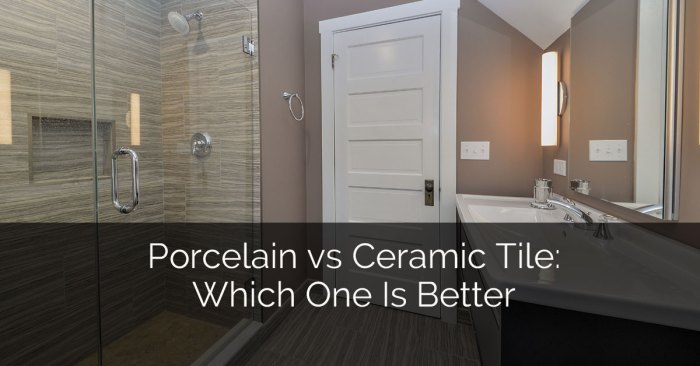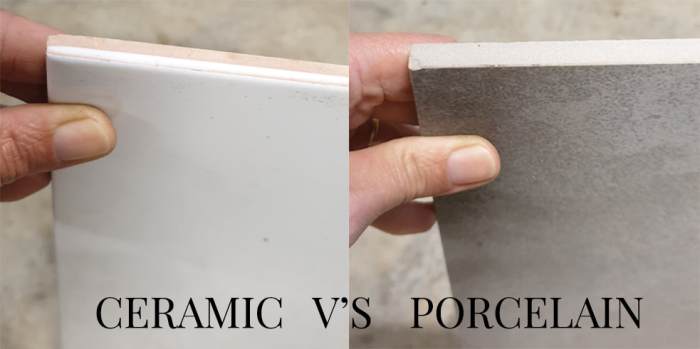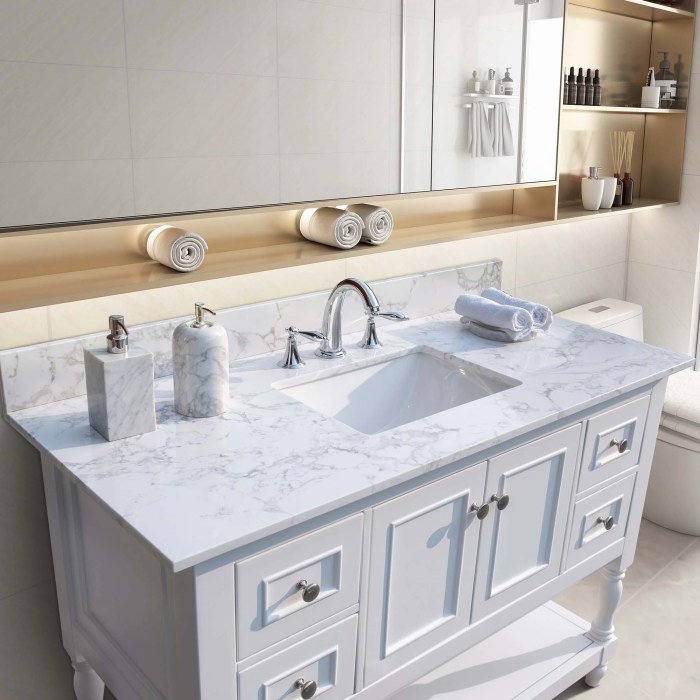In the realm of bathroom design, vanity tops reign supreme, setting the tone for the entire space. When it comes to selecting the perfect vanity top material, two frontrunners emerge: ceramic and porcelain. Both offer distinct advantages and characteristics, making the choice between them a matter of personal preference and specific bathroom needs.
This comprehensive guide will delve into the nuances of ceramic vs. porcelain vanity tops, empowering you to make an informed decision that complements your bathroom’s style and functionality.
From their physical properties and aesthetic appeal to maintenance requirements and environmental impact, we will explore every aspect of these two materials. Additionally, we will address frequently asked questions to ensure you have all the information at your fingertips. By the end of this guide, you will be equipped to choose the vanity top material that perfectly suits your bathroom’s needs and elevates its overall design.
Physical Properties
Ceramic and porcelain vanity tops are both made from clay, but they differ in their physical properties due to variations in their manufacturing processes.
The table below compares the hardness, durability, and porosity of ceramic and porcelain vanity tops:
| Property | Ceramic | Porcelain |
|---|---|---|
| Hardness | 7 on the Mohs scale | 8 on the Mohs scale |
| Durability | Good | Excellent |
| Porosity | 1-5% | <1% |
The higher hardness of porcelain makes it more resistant to scratches and wear and tear. The lower porosity of porcelain also makes it less likely to absorb stains.
Hardness
Hardness is a measure of a material’s resistance to scratching. The Mohs scale is a measure of hardness, with 1 being the softest and 10 being the hardest. Ceramic has a hardness of 7 on the Mohs scale, while porcelain has a hardness of 8.
Durability
Durability is a measure of a material’s ability to withstand wear and tear. Ceramic is a durable material, but porcelain is even more durable. This is because porcelain is fired at a higher temperature than ceramic, which makes it harder and more dense.
Porosity
Porosity is a measure of the amount of water that a material can absorb. Ceramic is a porous material, which means that it can absorb water. Porcelain is a non-porous material, which means that it cannot absorb water.
Appearance and Design
The visual appeal of ceramic and porcelain vanity tops plays a significant role in complementing the overall bathroom aesthetic. Both materials offer a diverse range of colors, patterns, and finishes to suit different design preferences and bathroom styles.
Ceramic vanity tops are available in a wide array of colors, from classic white and beige to vibrant hues like blue, green, and red. They also come in various patterns, including marble-like veining, geometric designs, and floral motifs. The glazed finish of ceramic tops provides a glossy sheen that adds a touch of elegance to the bathroom.
Porcelain vanity tops, on the other hand, are known for their exceptional whiteness and translucency. This gives them a more luxurious and upscale appearance compared to ceramic. Porcelain tops are available in a limited range of colors, but they offer a wider variety of patterns and textures, such as natural stone looks, faux wood grains, and intricate carvings.
Color and Pattern Options
| Material | Color Options | Pattern Options |
|---|---|---|
| Ceramic | Wide range of colors, including classic white, beige, and vibrant hues | Marble-like veining, geometric designs, floral motifs |
| Porcelain | Limited range of colors, primarily white and off-white | Wider variety of patterns, including natural stone looks, faux wood grains, intricate carvings |
Maintenance and Care
Maintaining the pristine condition of your bathroom vanity top is crucial for both aesthetic appeal and hygiene. Ceramic and porcelain, while durable, require specific care routines to preserve their beauty and functionality.
Cleaning Frequency and Methods
| Material | Frequency | Cleaning Method | Special Care |
|---|---|---|---|
| Ceramic | Regular cleaning | Mild detergent and warm water | Avoid harsh chemicals |
| Porcelain | Regular cleaning | Neutral pH cleaner or mild detergent | Rinse thoroughly to prevent soap scum buildup |
Additional Care Tips
- Wipe up spills and splashes promptly to prevent staining.
- Avoid using abrasive cleaners or scouring pads, as they can scratch the surface.
- For deep cleaning, use a commercial bathroom cleaner specifically designed for ceramic or porcelain.
- If you encounter stubborn stains, consult a professional cleaning service for guidance.
Cost and Value
The price of ceramic and porcelain vanity tops varies depending on factors such as size, shape, color, and finish. In general, porcelain vanity tops are more expensive than ceramic vanity tops. This is because porcelain is a denser and more durable material than ceramic.
However, both ceramic and porcelain vanity tops are relatively affordable compared to other materials such as granite or marble.
When considering the return on investment for a ceramic or porcelain vanity top, it is important to consider the durability and aesthetic appeal of the material. Both ceramic and porcelain are durable materials that can last for many years with proper care.
However, porcelain is a more durable material than ceramic, so it is less likely to chip or crack. Additionally, porcelain is available in a wider range of colors and finishes than ceramic, so it is easier to find a vanity top that matches the style of your bathroom.
Cost Comparison
- Ceramic vanity tops: $50-$200 per square foot
- Porcelain vanity tops: $75-$300 per square foot
The cost of installation will also vary depending on the size and complexity of the project. However, you can expect to pay around $100-$200 for the installation of a ceramic or porcelain vanity top.
Return on Investment
Both ceramic and porcelain vanity tops can provide a good return on investment. However, porcelain vanity tops are more likely to retain their value over time due to their durability and aesthetic appeal. If you are planning to sell your home in the future, a porcelain vanity top may be a better investment than a ceramic vanity top.
Installation and Customization
Ceramic and porcelain vanity tops share a similar installation process. Both materials require a sturdy base cabinet and a layer of adhesive to secure them in place. Specialized tools like a wet saw are necessary for precise cuts and shaping.
Customization Options
Both ceramic and porcelain offer a wide range of customization options. They can be cut to fit specific vanity sizes and shapes, allowing for a seamless integration into your bathroom design. Edge profiles can be customized to create a unique look, from classic ogee to modern waterfall edges.
Environmental Impact
When considering bathroom vanity tops, it’s important to think about the environmental impact of your choice. Ceramic and porcelain vanity tops have different environmental implications based on factors like raw material sourcing, manufacturing processes, and disposal.
Ceramic and porcelain vanity tops are both made from natural materials, but porcelain is denser and harder than ceramic. This means that porcelain vanity tops require more energy to produce, which can lead to a higher carbon footprint.
Raw Material Sourcing
Both ceramic and porcelain vanity tops are made from clay, which is a naturally occurring material. However, the specific type of clay used for each material can vary, and this can have an impact on the environmental impact of the product.
Ceramic vanity tops are typically made from red clay, which is a common type of clay that is found in many parts of the world. Red clay is relatively easy to mine and process, which means that it has a lower environmental impact than other types of clay.
Porcelain vanity tops are typically made from white clay, which is a rarer type of clay that is found in only a few parts of the world. White clay is more difficult to mine and process than red clay, which means that it has a higher environmental impact.
Manufacturing Processes
The manufacturing processes for ceramic and porcelain vanity tops are similar, but there are some key differences. Ceramic vanity tops are typically fired at a lower temperature than porcelain vanity tops, which means that they require less energy to produce.
Porcelain vanity tops are fired at a higher temperature than ceramic vanity tops, which makes them more durable and less likely to chip or crack. However, the higher firing temperature also means that porcelain vanity tops require more energy to produce.
Disposal
Ceramic and porcelain vanity tops are both durable materials that can last for many years. However, when they do eventually need to be replaced, they can be difficult to dispose of.
Ceramic and porcelain vanity tops are not biodegradable, which means that they will not break down over time. This means that they can end up in landfills, where they can take up space and leach harmful chemicals into the environment.
There are some recycling options available for ceramic and porcelain vanity tops, but these options are not always available or convenient. As a result, it is important to consider the environmental impact of your choice before purchasing a ceramic or porcelain vanity top.
Final Summary
Ultimately, the choice between ceramic and porcelain vanity tops boils down to your individual preferences and bathroom requirements. Ceramic offers a wider range of colors and patterns, making it ideal for those seeking a customized look. Porcelain, on the other hand, boasts superior durability and resistance to stains and scratches, making it a practical choice for high-traffic bathrooms.
Both materials offer excellent value for money, ensuring a beautiful and functional bathroom that stands the test of time.
As you embark on the journey of selecting the perfect vanity top, remember that the most important factor is to choose a material that aligns with your lifestyle and bathroom vision. Whether you opt for the timeless elegance of ceramic or the unparalleled durability of porcelain, you can rest assured that your bathroom will exude sophistication and style for years to come.



